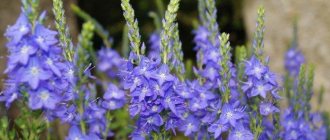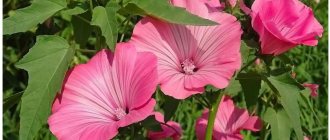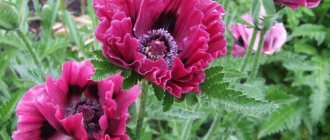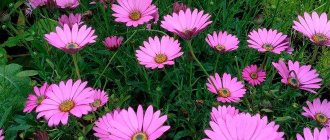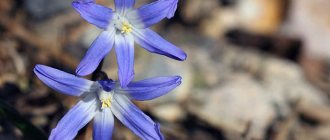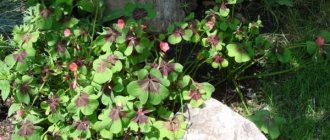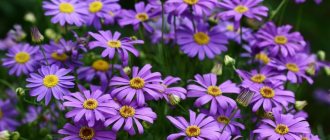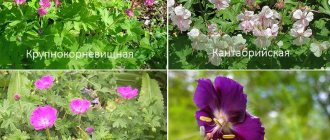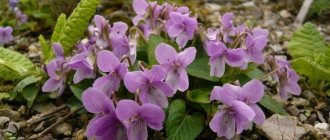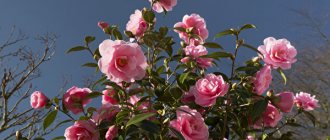Edelweiss only seems white, fluffy and defenseless. This mountain flower is called a symbol of perseverance and fearlessness. If a young man brought it to his beloved as a gift, it means he was not afraid to climb high into the mountains. And if a heavy boot or horse’s hoof crushes the plant to the ground, it will immediately straighten up and continue to look into the sky. The article will tell you what the edelweiss flower looks like, its cultivation, methods of propagation, use in landscape design and medicinal properties.
Edelweiss is called a symbol of perseverance and fearlessness
Reproduction and planting of edelweiss
Edelweiss from seeds for seedlings at home
Edelweiss seeds photo
Edelweiss is grown from seeds; seedlings are more reliable.
- In February or March, prepare a mixture consisting of two parts garden or deciduous soil, one part perlite, coarse sand.
- Sprinkle the flower seeds on top of the soil, pressing down with the palm of your hand.
- Water with a spray bottle, without over-wetting the soil.
- Cover the nursery with film or glass, maintaining the temperature at about 10 degrees.
- When seedlings appear, remove the cover and place the container with seedlings in a well-lit, warm place.
Edelweiss seedlings photo
- The seedlings will grow for a long time; upon reaching 2 cm, the seedlings are planted in separate pots for “growing”.
- Water moderately, not allowing the soil to dry out, but not flooding the plants, otherwise rot will appear.
Seedlings are planted in the ground at the end of April - beginning of May, maintaining a distance of about 15 cm between flowers.
Growing edelweiss from seeds in open ground
How to sow edelweiss in open ground Photo of seeds
In nature, light edelweiss seeds are carried by the wind and, when clogged in cracks between rocky soil, they easily germinate even in the absence of soil, if there is enough moisture. Therefore, when sowing, you should not bury the seeds too deeply; it will be difficult for them to break through the thickness of the soil.
In order not to fool around with the seedlings, sow the seeds directly in the already warmed soil, without the threat of frost, on the site - the “alpine hill”. Planting depth is 1-2 cm, the distance is as small as possible, after which you will have to thin out the seedlings, leaving 7-8 cm between them. Grown bushes can be planted less frequently, leaving 15-20 cm between them.
Edelweiss shoots photo
For both sowing cases, it is recommended to stratify the seeds for about three weeks - mix the seeds with moist soil and put them in the refrigerator in a bag for one to two weeks.
It takes about a couple of months to wait for seedlings, but under suitable conditions, seedlings can appear within a week.
Dividing the bush
Perennial bushes can be divided, acting extremely carefully, trying to injure the roots as little as possible. It is better to use a sharp garden tool or a well-sharpened knife. The bush is carefully dug up, trying not to disturb the ground, and cut into 2-3 parts with several growth points. The recommended distance between the resulting plants is 20-30 cm.
Growing buddleia from seeds
Sowing Buddleia
Buddleia seeds collected from your own bushes may not ripen in our conditions without additional tricks such as preliminary stratification or sowing on a layer of snow, and if you want to be guaranteed to grow Buddleia from seeds, then it is better to buy seed material - specialized stores sell excellent seeds of well-known import companies. To facilitate the sowing process, it is better to mix small buddleia seeds with sand and then sow them on loose neutral soil in wide bowls with drainage holes and a drainage layer under the soil.
There is no need to embed the seeds, just lightly press them to the surface of the soil and, after spraying the crops with a spray bottle, cover the container with glass or transparent plastic film and place in a warm (22-25 ºC), light, but without direct sunlight, place. Sowing is carried out in early spring. Budleya sprouts from seeds in two to three weeks; the emerging seedlings must be ventilated, the soil must be moistened, and in order to avoid the seedlings becoming infected with the “black leg”, it must be watered from time to time with a pink solution of potassium permanganate.
Description of the Edelweiss flower
The plant is completely covered with dense fibers that prevent moisture evaporation, protect against cold and give it a white-silver “luminous” color. They occupy an area of 15-25 cm, tightly entwining the ground with many roots. Flowering - baskets of white or yellowish flowers without fragrance, collected in inflorescences, surrounded by star-shaped perianths.
It blooms in gardens from June to August, forming small rosettes of leaves by autumn. To propagate, carefully separate the tenaciously intertwined roots.
Botanical description
Gardeners who want to grow an exotic plant in their garden, having heard about edelweiss and its properties, often do not even know what the plant looks like. The plant is an annual or perennial herbaceous crop, reaching a height of 25 cm. Edelweiss grows at high elevations, so it is usually found near the ground.
Edeilweiss is a “noble white” flower, as it is translated from German, where the name of the culture comes from. As the flowers grow, they form small thickets of 5-6 bushes. The tops of the inflorescences, shaped like baskets, are considered decorative.
Edelweiss bushes, or leontopodium, consist of several curved stems. The rhizome of the plant is small and consists of adventitious roots. A small rosette forms at the root collar.
The leaves are elongated and narrow. The leaf plate underneath is covered with thick fibers that do not allow moisture to evaporate. The outer part of the foliage is silver in color, making the entire plant appear that shade. The upper leaves of the inflorescence form a star shape. At the same time, the lower part of the leaves is dark green, and the upper part is white-silver.
Edelweiss blooms in small inflorescences collected in lumps. The flowers are white or yellowish, consisting of a core and 5 long petals spread out in different directions, having an intricate curved shape. Even after cutting and drying, you can observe the unusual silver color and shape of the flowers. Flowering begins in early June and lasts about a month. When edelweiss blooms, the crop is filled with an unusual combination of yellow and silver tones.
After flowering ends, an ovule is formed in place of the buds - a box in which the seeds ripen. Edelweiss fruits are small, with pinwheels that allow the seeds to be dispersed by air flow.
Edelweiss in landscape design
Edelweiss what to plant with Combination with other flowers photo
Edelweiss is wonderful for rock gardens, good for planting in groups, but you should not plant them with bright flowers, otherwise their beauty will be lost.
Edelweiss flower description photo with Alpine asters
Retaining color and shape for a long time, they are suitable for dry winter bouquets - cut off the flower stalks before opening and dry in a well-ventilated room, hanging the flowers down.
Edelweiss on an alpine hill
Edelweiss combines beautifully with alpine asters, arctic poppies, juveniles, blackheads, ornamental cereals, heuchera, and meadow sage.
Edelweiss in a flower bed with other flowers, what to plant with
Description and features of edelweiss
There are many legends around the Alpine star. According to one of them, a girl who lived high in the mountains fell in love with a young man from the lowlands. However, they were not allowed to meet each other, and the young maiden, approaching the edge of the cliff, shed bitter tears down. In the place where they fell, flowers of unusual beauty grew, which are still associated with love and fidelity. The plant is also an unspoken symbol of climbers. Already in our time, the International Union established the Order of Edelweiss, which was awarded to the best climbers.
Leontopodium (lat. Leontopodium) is a herbaceous crop from the genus Dicotyledons, belonging to the Asteraceae family. They are annual or perennial flowers growing in small bushes. Their height ranges from 10 to 35 cm, the stems are straight, covered with narrow lanceolate leaves, which form a dense rosette at the base. The inner side of the leaf blades is densely pubescent, which allows the plant to retain moisture, and the outer side is painted in a silver-gray hue.
Alpine star is the second name for edelweiss
Edelweiss blooms from June to July, producing complex star-shaped inflorescences. They consist of several tubular baskets of yellow or white color and marginal needle-shaped petals of a snow-white color. All petals are covered with short fluffy pile, which makes the flower seem to be slightly crushed by snow.
Distribution and habitats
Leontopodium is a resident of the alpine and subalpine zone. In the wild, it grows at an altitude of at least 1.8 km, inhabiting rocky mountain slopes (Alps, Himalayas, Carpathians, Tibet). Some varieties are found in Siberia, Mongolia, and sometimes even Korea. There, the culture also grows exclusively on rocky terrain.
Chemical composition and beneficial properties
By studying the biochemical composition of edelweiss, scientists have discovered many useful components. So, the green part of the plant contains:
- ascorbic acid;
- vitamins A and K;
- trace elements (K, Ca, Mg);
- tannin;
- antioxidants.
Herbal remedies based on leontopodium have an antibacterial effect, relieve inflammation, relieve cramps, remove phlegm and harmful substances. The plant also has immunostimulating, tonic properties, helps relieve nervous tension, and alleviate the effects of stress.
Edelweiss essential oil is used in cosmetology
Collection, preparation and storage of raw materials
Edelweiss is listed in the Red Book as an endangered species, and therefore folk healers use flowers grown on their plots. Harvesting is done in the summer, when Leontopodium blooms. Using sharp scissors, carefully cut the stems and hang them to dry in the shade. The finished raw materials are laid out in fabric or paper bags, where they are stored for no more than 3 years.
Application in medicine
Tibetan monks were the first to use the beneficial properties of the Alpine star. They treated diseases of the respiratory system, gastrointestinal tract, as well as cardiovascular problems with the plant. The chemical components that make up edelweiss help lower blood pressure, relieve joint pain, and remove stones from the bile ducts. To slow down the aging process, the flower is often used in the manufacture of anti-aging cosmetic products.
Harm and contraindications
Unlike other medicinal crops, Leontopodium does not contain harmful substances and is also not toxic. There are no strict contraindications to it. People with individual intolerance, pregnant and lactating women need to be careful.
The Legend of Edelweiss
Once upon a time, on the tops of the Alpine mountains, there lived an incredibly beautiful fairy girl who fell in love with a charming young man who lived at the foot of the mountains. The young man could not climb so high into the mountains, and the fairy had no right to go down. The fairy grieved, and the tears rolling down the mountain slopes turned into an extraordinary flower. There are many other legends about the origin of edelweiss, telling about great love, bravery and courage, because the places there are harsh! In search of a flower one needs to spend many days in the mountains, so they imagine that if a man gets a flower for his beloved, this means his true feelings and devotion.
The name “Edelweiss” consists of two German words “edel” - nobility and “weiss” - white, which literally means “noble whiteness”. This is a truly noble and delicate flower that deserves the attention of gardeners.
It’s good that the miracle flower is now available to everyone, you just need to try a little!
Modest and unpretentious edelweiss is able to decorate even the most demanding alpine hill with its unusual appearance. Translated from Latin, its name sounds like “lion's paw.” This is due to the original shape of the pubescent flower. One of the many varieties of plants of this genus is alpine edelweiss, the photo of which you see below. It is very decorative, but not so difficult to grow and care for.
Edelweiss flower legend
This beauty is included in the list of plants in the Red Book of Russia. The plant is threatened with complete extinction, because at the moment its number in nature has decreased significantly.
edelweiss flower photo in the wild
The Swiss consider it a symbol of the country. But, unfortunately, the flower is now extremely rare in Switzerland. The government even passed a law prohibiting the collection of edelweiss in order to protect it from tourists and preserve it in natural conditions.
Where does it grow? It grows in the rocks of Tibet, the Himalayas, the Carpathians and the Far East. What does an edelweiss flower look like? It looks like a small silver star or pearl. This herbaceous perennial plant is 15-30 cm in height, and grows to a width of about 20 cm. The outer area of the leaf blades is painted bright green, and the lower one is covered with small white villi that protect the foliage from frost.
Translated from German, the name means “noble white”. The French call it the Alpine star. In Switzerland he is known as the “Queen of the Alps”. And all over the world this plant symbolizes love, devotion and courage.
Edelweiss: a legend about a flower
If you look at it objectively, this modest flower is not at all surprising in its beauty compared to other plants. But it amazes with its mystery. Long ago, men even risked their lives to bring mountain edelweiss for their lovers; this was a symbol of courage and courage. This flower is surrounded by many legends and myths.
One legend tells of an unusually strong feeling between two lovers who faced eternal separation. But they chose to jump off the cliff together. And then, in that place, edelweiss trees grew on the stones, as a sign of triumph and sadness.
There is also a more fantastic legend, it tells about mythical beauties with long nails who live on high steep cliffs. They grow edelweiss, care for it and protect it from people. The brave men who steal their flowers are thrown into the abyss by the beauties. Only people with real and sincere feelings are allowed to take the star with them.
Having become acquainted with the legends about the “silver star”, you understand why many want to conquer this mountain flower and grow it on their farm.
Description of the plant
As you can easily guess from the name, this species grows in the subalpine and alpine zones of Europe, Asia Minor and Central Asia. The plant can also be found at lower altitudes relative to sea level. However, under such conditions it loses its decorative felt pubescence. Alpine edelweiss grows on exposed limestone, gravelly slopes, cliffs and cornices.
This is a herbaceous plant with slightly curved stems, forming compact bushes 20 to 30 cm high. They sometimes branch in the upper part. The leaves of this variety of edelweiss are lanceolate, forming a beautiful basal rosette. Flowers of unusual shape (foot-shaped) are collected in baskets that form scutes. The fruit is an achene. Flowering lasts only two weeks in mid-summer.
The entire plant as a whole is very pubescent. Alpine edelweiss has a beautiful silver-green hue. In nature, this property serves as a special adaptation to the cold highland climate with constant fog. The plant is often depicted on coats of arms, coins, and postage stamps. There are even Roman tombstones from the beginning of our millennium depicting flowers. Edelweiss is considered a symbol of mountains, inaccessibility, and survival.
Plant species
Currently, botanists are studying about sixty species of edelweiss. Each flower of a certain species has its own distinctive characteristics, which are so obvious that they make it possible to determine the species of the plant even from a photo. The most famous types of edelweiss include such specimens as alpine edelweiss, Fedchenko's edelweiss, Siberian edelweiss, or Palibin's edelweiss.
If we describe Alpine edelweiss in more detail, then first of all I would like to note that it belongs to the Compositae family. This species is a relative of the herbaceous perennial plant, which has a slow growth rate. It has beautiful silver-green foliage and beige-whitish flowers, the size of which can vary up to ten centimeters. The flower surface has a small fluffy layer. The place of birth is considered to be the mountain ranges of the central and southern part of the European continent.
Sometimes representatives of this species can grow up to thirty centimeters high. Due to the root system, which has creeping properties, the plant clump can grow at a distance of 25 cm. Due to this advantage, the plant is often used as a ground cover on a personal plot. For the growth of alpine edelweiss, it is important to have a cool climate and sufficiently drained rocky soil or sandy soil, if we take into account its natural habitat. Negatively relates to hot weather conditions combined with high humidity. The flowering process begins at the end of summer and continues until the beginning of autumn. In the winter season, in the presence of severe frosts, the process of flower dying may begin, but thanks to the persistent root system, the plant will be reborn again when spring comes.
The most famous type of edelweiss is Alpine
Alpine edelweiss is great for creating rockeries and rock gardens, and dried flowers can be used as part of a winter bouquet.
Another interesting species is the Palibina edelweiss. This species is very similar to the Alpine representative, however, the size of the formed bush is much larger, but the flower is inferior in its parameters to the inflorescence of its Alpine relative. This species is an inhabitant of the mountainous regions and steppe regions of Eurasia, and also grows on the territory of the Korean Peninsula.
Edelweiss Palibina
Use in horticultural culture
Because of its beauty and originality, edelweiss has been used by humans in gardening for a long time. It is especially relevant when creating rock gardens and slides. It looks good when planted in the foreground in small groups. The high decorative value of the plant remains even after the end of the flowering period. Cut edelweiss can stand in water for a long time. When dried, it does not lose its shape or silver color, so it is often used in winter “dry” bouquets. The best neighbors for him on hills and in rock gardens will be miniature (dwarf) rose bushes, ageratum, aquilegia, violet and alpine aster.
Chemical composition
The edelweiss herb contains a large amount of minerals and vitamins. The composition of the plant is determined by the content of potassium, calcium and magnesium. The vitamin composition is due to ascorbic acid, vitamins A and K. The plant also contains flavonoids and tannins, tannins and phenols.
You might be interested in: Hedgehog
Due to the content of useful substances in its composition, the plant is actively used in folk medicine. The culture is effective for treating diseases such as:
- gallbladder pathology;
- disorders of the heart and blood vessels;
- hypertonic disease;
- rheumatism;
- whooping cough.
The plant is actively used in cosmetology because it has anti-aging properties. The culture is added to various creams and cosmetics. Edelweiss contains no toxic substances, as well as poisonous and harmful components.
Choosing a location and soil for the plant
It is completely logical that the alpine edelweiss flower prefers well-lit, sunny places. The plant is drought-resistant; moreover, it absolutely does not tolerate waterlogging and stagnation of water in the soil. For edelweiss, light, well-drained soils are most optimal.
When planting a plant, it is advisable to add leaf soil, coarse sand or crushed stone. This will help create conditions as close as possible to those in which it grows in its natural environment. Do not use heavy soil or overly nutritious substrates with a high organic content. Combined with high humidity, this will lead to a loss of decorative appearance of the plant, including beautiful pubescence, and strong elongation of shoots.
Planting at home
It is impossible to grow edelweiss in a home environment under constant conditions, since the bushes are difficult to domesticate. However, seedlings are obtained indoors for further planting of the crop in the garden. This method is quite reliable, if the conditions are met, it allows you to grow a high-quality crop.
When deciding to grow edelweiss seedlings, it is important to choose the right time to sow the seeds. Planting material is placed in the ground at the end of winter or early spring
At the same time, the soil and containers for sowing are prepared in advance.
The soil for edelweiss is chosen carefully, since under natural conditions the plant lives only in a certain substrate. The soil must contain a drainage layer - perlite or coarse sand, crushed brick. Also mix equal parts of leaf soil and turf. Edelweiss loves loose and nutritious substrate, despite the fact that it grows in mountainous regions.
Before sowing, the soil is slightly moistened. The seeds are distributed over the surface of the container, then pressed lightly with the palm of your hand. To speed up the process of germination, the containers are covered with film, which is removed daily for ventilation. Before the seedlings appear, the containers are placed in a cool place, the temperature of which should not exceed 12 degrees.
After the seedlings appear, the film on the containers is removed, and the containers with the seedlings themselves are placed in a bright and warm place. When the seedlings reach 2 cm in size, they are planted in separate pots for further cultivation.
When to plant in open ground
Planting of grown seedlings in open ground is carried out when the plant is overgrown with permanent foliage. In addition, an important rule for transplanting into the garden is to warm the air and avoid constant frost. In order for the plant to take root better, the soil must warm up to a temperature of 15 degrees. When transplanting, leave a distance of about 15 cm between the crops. Since the crop is not large in size, you can remove it from the container using a regular spoon. After transplanting, the seedlings are covered with boxes or jars until they take root and take root.
Home care
Caring for edelweiss seedlings involves timely watering. The soil should not be allowed to dry out, as this can harm the sprouts.
In addition, it is important to regularly ventilate the plants by removing the film from the container for several hours every day. Immediately after sowing, the planting material is placed in a cool, dark place where the air temperature does not exceed 15 degrees
With the appearance of sprouts, the container is placed in a lighter and warmer area, where the air warms up to 20 degrees.
Since air humidity is high in the natural environment where edelweiss grows, it is also maintained at maximum levels when growing seedlings. Watering of plants is carried out moderately; both drying out and waterlogging of the soil should not be allowed.
Alpine edelweiss: cultivation
The plant belongs to the category of unpretentious. However, to grow it in your garden, you will have to make some efforts. At first glance, the flower seems inconspicuous. Indeed, if you plant it in a company with tall perennials, nothing good will come of it. Firstly, he will not have enough light. Secondly, he will simply get lost among them. Edelweiss needs to be emphasized with a suitable environment, highlighted on a hill with the help of stones, and a small group of plants created - only then will it attract attention.
As mentioned above, the plant does not like excess moisture. Therefore, it has enough natural precipitation. Moreover, if the summer is very rainy, then it should even be covered. Only in hot and dry months does edelweiss need to be watered additionally. The second important component of plant care is weeding and loosening (very superficial so as not to damage the roots).
Young alpine edelweiss at the age of 1-2 years needs light shelter for the winter. You can use fallen leaves or branches of coniferous plants. In spring, the shelter should be removed as early as possible so that the shoots are not blocked. The plant grows well in soils rich in lime. Therefore, do not forget to periodically feed it with all the necessary microelements during the active growing season.
How to properly care
Despite the fact that in the wild, edelweiss grows in places where there are no comfortable conditions, garden shrubs are very demanding. If the plant is not planted and cared for properly, edelweiss quickly rots and dies.
The soil
In its natural environment, Leontopodium often grows in a rocky crevice where there is no substrate. Garden plants require a loose and well-drained substrate - perlite, sand. The soil should not contain organic matter or mineral fertilizers; edelweiss does not tolerate them.
Watering
The crop must be watered regularly as the soil dries out. Some varieties grow well on their own; rare rains are enough for them. Water should not be allowed to stagnate in the ground, so in rainy times water should be drained.
Top dressing
Edelweiss does not require any feeding. Even a small ingress of minerals and organic matter into the substrate can lead to rotting and drying out of the plant.
Weeding and loosening
Edelweiss is quite unpretentious in growing conditions. gardeners do not recommend loosening the soil, as this can harm the crop. However, an important rule for proper cultivation is the timely removal of weeds.
You might be interested in: Mordovnik
In order for edelweiss to develop normally, experienced gardeners make a mulch layer around the bushes, which will not only avoid excess weeds, but also maintain sufficient soil moisture. Sawdust and dry leaves are chosen as mulch.
Transfer
When growing perennials, the crop is transplanted to a new location twice every five years. This is due to the fact that the perennial takes the necessary substances from the soil, and the soil becomes depleted.
Edelweiss is replanted in the spring. New holes are first dug. As the rhizome of the flower increases in length, the holes must be deep enough so that the rhizome remains intact. After digging the individual out of the ground, the roots are carefully straightened, the crop is placed in a new place, then carefully covered with earth. Watering is usually carried out after replanting all plants. A sign that the plants have taken root in a new place is the appearance of new stems on the bushes.
Flowering after transplantation begins, as a rule, after a year, since edelweiss spends most of its energy on restoring the root system and engrafting in a new place.
Trimming
Pruning is not necessary for edelweiss, since it is a naturally compact and minimalist bush. Despite the fact that pinching will not do much harm to the culture, the edelweiss will still not become more magnificent and decorative.
Temperature and humidity
In the natural environment, when edelweiss blooms, the weather is quite changeable, there are sharp changes in air temperature. Despite the fact that the culture is unpretentious, it does not tolerate extreme heat. If planting is carried out in regions with a hot climate, during the active growing season the plants are provided with partial shade during intense heat.
Gardeners do not recommend planting edelweiss near water sources, since the flower does not like constant high air humidity.
How to protect flowers from aging
Active vegetation of edelweiss continues for the first 1.5-2 years. Then the bushes begin to age. In order to prevent the withering of the crop, edelweiss is rejuvenated by dividing the bush.
The procedure for dividing the bush is as follows:
- immediately after the snow melts and seedlings appear, leontopodium is dug out from the substrate;
- The mother bush is divided into several parts so that each section has roots.
- All obtained parts are placed in a new place of growth.
This method of division allows not only to propagate the crop, but also to improve a larger area. If rejuvenation is not carried out regularly, the plant dies within 5 years after planting in open ground.
Plant propagation methods
Edelweiss can be propagated in two well-known ways: vegetative and seed. Moreover, each has its own advantages. During seed propagation, the original characteristics of the plant are lost, that is, those that it possessed in its natural growing environment. This causes the flower's appearance to vary greatly depending on where it is grown. Therefore, in order to preserve the characteristics of the variety, use the vegetative method. It is quite simple and clear.
Vegetatively, alpine edelweiss is propagated in spring or autumn by cuttings or dividing the mother bush. In autumn, an adult specimen consists of several annual rosettes, which are very tightly intertwined with each other by roots and are essentially independent plants. They are carefully separated and seated in a new place. Young edelweiss will bloom in the summer following winter. The tops of the shoots are suitable for cuttings, but not too old. They take root easily in the spring (May-June), and bloom the following summer.
How to protect flowers from aging
During the period when edelweiss blooms, having reached a year and a half, it is considered their youth. It's a shame that after a couple more blooms they become mature and begin to age. To protect them from this and preserve them in the rock garden, you need to start the propagation procedure by division.
To do this, in early spring the bush is dug up and divided into 10 or more parts. All parts can be planted by propagating the plant in this way. But in a few years, when the flower fills all the necessary places, you will have to get rid of unnecessary parts, sending them to compost or delighting your friends with exotic seedlings.
Rejuvenation is the key to good growth and beautiful appearance. Edelweiss, planting and caring for (photo) which prevents the division of the bush, will begin to die in five years. After all, it does not grow over the area of the flower bed, and at the same time it practically suffocates itself with roots.
Alpine edelweiss: growing a flower from seeds
In order to grow a flower, you need to go to the store and buy a bag of seeds. Sowing is carried out in February-March in light nutrient soil. The container with the crops is covered with glass to preserve moisture and heat and placed in a shaded place. Seed germination temperature is 13-15 °C, the first shoots can be observed in 2-3 weeks. After there are more of them, the shelter is removed and the container is transferred to a bright place. Seedlings grow quite slowly. The main thing during this period is not to flood them. Plants that have reached a height of 2 cm are planted in separate pots.
Frankly speaking, edelweiss, compared to many other flowers, is not at all striking in beauty. But this is only at first glance. This small flower is shrouded in many secrets. In particular, it has long been considered a symbol of love, fidelity, and courage. Perhaps because once upon a time men, risking their lives, tried to get this flower high in the mountains for their loved ones. Therefore, it is not surprising that you really want to conquer this “highlander” by trying to grow it on your own plot. Read this article on how to do it with minimal effort.
Edelweiss , or Leontopodium, is a genus of herbaceous plants of the Asteraceae family, common in the highlands of Europe and Asia.
Alpine edelweiss (Leontopodium alpinum). © Hurni Christoph
What is edelweiss?
Not very bright. Therefore, if you plant it among roses, gladioli or phlox, the edelweiss will simply “get lost.” But if you create the appropriate conditions for it on your site by placing it on an alpine hill, that’s a completely different matter. By the way, alpine edelweiss can only be found in the Carpathians and the Alps, where it grows at an altitude of 1700-2000 m. There is also a Siberian species - Palibin edelweiss (Leontopodium palibinianum), growing in the mountains of Siberia, Mongolia and Korea, it is larger than the alpine one.
Alpine edelweiss (Leontopodium alpinum) according to modern classification is considered a subspecies of snowy edelweiss (Leontopodium nivale) - Leontopodium nivale subsp. alpinum.
Often Siberian edelweiss is called a subspecies of the plant “Pink cat's paw” (Antennaria rosea subsp. confinis), which is incorrect from a botanical point of view.
The leaves and stems of edelweiss are covered with grayish-felt pubescence, which protects the plant from excessive evaporation of water - this is how nature wisely ordered it. The flowers are mostly snow-white. Inflorescences are baskets collected in dense heads. They are usually surrounded by a “star” of apical leaves. In France, the plant is called the Alpine star. At the same time, the inflorescences vaguely resemble the imprint of a lion's paw. Therefore, the scientific name - Leontopodium - translated from Greek means a combination of the words “lion” and “leg”. The common name "edelweiss" comes from the Greek words for "noble" and "white." Blooms in June-August.
Edelweiss care
Edelweiss does not require special care. This is an annual or perennial light-loving, drought-resistant plant. Prefers light, dry, calcareous soils and does not tolerate stagnant water. Since this is a true mountain resident, it is advisable to add crushed stone or coarse sand to the soil when planting.
Unlike many other flowers, edelweiss does not benefit from rich soil. Because of this, it loses its decorative effect. At the same time, it thrives on poor soils, in crevices between stones.
Edelweiss Palibina (Leontopodium palibinianum). © T.VoeklerPropagation of edelweiss
Edelweiss is propagated most often from seeds, preferably by seedlings, sowing it in February-March in a soil mixture of deciduous soil and sand (2:1). The seeds are not deepened, but scattered over the surface of the soil. The box is covered with glass or film, which is removed when shoots appear. Plants grow slowly.
At the end of April and beginning of May, seedlings can be planted in open soil. You can propagate edelweiss by dividing the bush in spring or autumn. True, edelweiss bushes are very closely intertwined with their roots, so when dividing they should be taken apart very carefully. They will bloom next year. Plants can grow in one place for 2-3 years. So that they do not lose their decorative properties, they should be transplanted to another area.
Snowy edelweiss (Leontopodium nivale). © Bjorn SPartners for edelweiss
The height of edelweiss is 15-20 cm, so it is so important not to “crowd” it with other plants. Its partners can only be such low crops as alyssum, gypsophila, tenacious, sedum and other ground cover plants.
If you manage to grow edelweiss at home, you can rightfully be proud of it. In addition, the plant is listed in the Red Book, and therefore it is necessary to protect it and promote its spread. In addition, even in winter, edelweiss can delight you with its beauty, since it is often used as a dried flower for making winter bouquets. At the same time, it retains its shape and silver color.
Poets have created many legends about edelweiss flowers - about courage, loyalty and love. The plant itself resembles miniature mother-of-pearl pearls or silver radiant stars scattered by nature along the rocks of snow-capped mountain peaks. "Alpine Star" in France, or "Silver Flower of the Rocks" in the Italian Alps grows on mountain slopes with unenriched soils or on rocky soil.
Edelweiss care
Edelweiss does not require special care. This is an annual or perennial light-loving, drought-resistant plant. Prefers light, dry, calcareous soils and does not tolerate stagnant water. Since this is a true mountain resident, it is advisable to add crushed stone or coarse sand to the soil when planting.
Unlike many other flowers, edelweiss does not benefit from rich soil. Because of this, it loses its decorative effect. At the same time, it thrives on poor soils, in crevices between stones.
Edelweiss Palibina (Leontopodium palibinianum). © T.Voekler
External description of the flower
Even an amateur gardener knows what an edelweiss flower looks like. It is a low growing herbaceous plant with beige-white flowers and attractive foliage. The average height is up to 35 cm, width - 22. The white bract, framed by a yellow edging, reaches 10 cm in diameter. Baskets of inflorescences are collected in dense heads. Edelweiss gradually expands as it grows thanks to self-seeding and creeping underground rhizomes.
Grows well both from seeds and from soil roots. The flowers are softly pubescent and stand out against the green-silver foliage. The Latin name was given to the plant for its external resemblance to a lion's paw.
The alpine flower looks great in borders. Blooming in late summer, edelweiss will delight the owner until the end of autumn. Then the dried inflorescences can decorate festive winter bouquets.
Types and varieties
Perennial flowers for the garden: photos with names (catalog)
Botanists count more than 50 types of culture. However, today only a few species are commonly found and are subject to selection. Based on the latest data, the most popular varieties of edelweiss are:
Alpine
Small herbaceous bushes growing up to 20 cm in height. A feature of the culture is the presence of terry apical leaves of silver color. The crop blooms in summer with small yellow inflorescences. The top view of the plant resembles a star, with long lateral shoots. The diameter of the inflorescences reaches 10 cm.
The culture is considered one of the longest-livers, since with constant rejuvenation the flower can live for many years. The development of culture is quite slow compared to other species. The Alps, namely the southern regions of the country, are considered the birthplace of edelweiss.
A feature of growing alpine edelweiss varieties is considered to be the creation of a cool climate, which is necessary for the normal development of the crop. Some varieties are quite tall, but this does not prevent the crop from being used as a ground cover.
Two-color
A feature of the culture is the presence of a double layer of apical foliage. At the same time, leaves of various shapes are arranged in 2 rows, and the resulting “star” consists of 10 rays. The diameter of the inflorescence is about 5 cm. The lower foliage on the plant is dark green in color. The culture itself is quite tall for its genus, reaching 35 cm. The leaves that make up the rosette are whitish in color.
Kuril
A plant that lives only on the territory of the Kuril Islands. It is a low-growing shrub, up to 20 cm in size, with erect stems and short foliage. The bract is wide, forms a star of leaves, pubescent on all sides. The leaves are white.
Edelweiss-shaped
One of the tallest representatives, reaching a size of 35 cm. Erect stems are bare, thin. The leaves on the plant are attached at the base, petiolate, linear structure. The color of the apical foliage is grayish. The perennial does not form a rosette at the base of the root collar. The number of leaves on numerous stems reaches 30 pieces, while the leaf blades themselves are medium-sized, about 4 cm in length and 0.5 cm in width. The inflorescences are small, consisting of 2-5 baskets, reaching 1 cm in diameter.
This variety is perfectly preserved when dried, so it is often used to create decorative flower arrangements that are strong. The plant is also effective in folk medicine as a remedy for treating pathologies of the liver and gall bladder.
Siberian
An endemic plant that lives in Siberia. It is considered close to the Alpine edelweiss. Felt apical foliage is oblong, with edges curled downwards. The inflorescences-baskets are yellow and small. The stems are erect, the basal rosette of leaves is dark green in color. The size of the bushes is slightly higher than their counterparts, about 35-40 cm.
Pale yellow crowded
The peculiarity of this variety is the curling of the foliage at the base of the bract. The leaves are oblong, and the fibers on the stem fall off as the plant grows. The foliage is colored in green-yellow shades. The height of the perennial ranges from 5 to 25 cm. The stems on the bushes are crowded and numerous. The foliage on the bushes is quite large, about 4 cm in length. The diameter of the inflorescences is about 7 cm.
Dwarf
A variety whose height reaches 10 cm. This is the smallest representative of edelweiss. In the natural environment, it is relatively rare to find such bushes, since they live at an altitude of more than 3500m. Inflorescences - baskets consist of several yellowish flowers collected together. The bracts are elongated and flat in shape. This is the only species whose bracts do not form a star.
Stepnoy
The height of this mountain plant is 20 cm. The stems in the bush are crowded, consisting of erect, villous stems. The flowers in the inflorescences are pubescent and light in color. The bracts are flat, milky in color. The star formed by the bracts has an irregular shape.
Characteristics of popular varieties
There are more than 40 plant species in floriculture. Of these, only five varieties have reached widespread distribution:
- Edelweiss alpine . The terry apical leaves form a multi-rayed star. The pride of the Alpine edelweiss is the fleecy silver leaves of a lanceolate shape, forming a basal rosette. The stem of the plant reaches a height of 20 centimeters.
- Siberian . A genus close to the alpine grows in the steppe and mountainous regions of Korea, Mongolia and Siberia. Large bushes are decorated with miniature inflorescences. The plant develops in permeable, dry and unfertilized soil. Propagated by spring division of rhizomes or seeds in summer.
- Pale yellow . Single stems are covered with sparse oblong leaves. The edges of the leaves are curled and have a pale yellow or greenish color. The inflorescence star rarely has the correct geometric shape.
- Kuril . The flower, reaching a height of no more than 18 cm, is squat. Straight stems are decorated with felted drooping leaves. The shape is narrow-lanceolate.
- Two-color . The difference is soft felt leaves near the inflorescences. Distributed in Japan and Sakhalin. The variety prefers rocky sea slopes and river banks.
Characteristics of the plant
Edelweiss is a herbaceous plant reaching a height of 15-25 centimeters. It has narrow leaves, which, thanks to their fleecy pubescence, are able to retain moisture for a long time. The inflorescence is a basket of white or yellow flowers. It is surrounded by star-shaped, spreading leaves.
Thanks to its creeping rhizome, edelweiss is able to grow independently. Due to this quality, the flower is used as a ground cover planting. But in order to grow it on his own plot, the gardener must provide the plant with conditions close to natural.
Features of growing a plant
The stereotype that edelweiss grows only high in the mountains has long been refuted. Many modern gardeners cannot imagine a garden without mysterious alpine inflorescences.
Useful tips for gardeners
If you decide to grow this beautiful flower in your garden, you should know some of the features of its “character”. They will help you avoid mistakes and get a great landscape decoration:
Also
- The flowering time of edelweiss depends on the variety. It can begin in June and end in August or even at the very end of autumn.
- When planting on a home plot, coarse grained sand or fine crushed stone should be added to the soil due to its mountain origin. This will allow conditions to be as close to natural as possible.
- Edelweiss simply does not need nutritious soil rich in minerals. It will oppress the plant. There will be a loss of decorative properties.
- The optimal fertilizer will be humus. It is recommended to apply it in the first weeks of spring, when the flower is most weakened.
- Open compositions and sunny places benefit the alpine flower. It produces many shoots and the inflorescences become larger.
- Edelweiss is resistant to winds and even bright sunlight.
- In the wild, all representatives of the alpine flora spend the winter under the snow. If a gardener wants to see edelweiss in his rock garden, where there is no precipitation, then they need to be mulched, creating an imitation of snow cover. It is recommended to remove mulch at the very beginning of spring.
- You should carefully choose neighbors for your flower. Tall and lush roses, phlox and gladioli are not the best option, since the edelweiss will get lost against their background. Sedum, gypsophila and alyssum will fit perfectly into the composition.
Methods for propagating edelweiss
It will be easier for beginners and amateurs in gardening to buy ready-made seedlings and start planting them. Experienced gardeners prefer sowing seeds. Edelweiss propagation has important nuances:
- Parachute seeds are completely ready for planting at the end of February and beginning of March.
- The optimal soil mixture consists of deciduous soil and sand in a 1:1 ratio.
- The seed is not buried inside the soil. It is enough to scatter them over the surface of the box. The container must be covered with glass or tightly filmed, removed only when the first shoot appears.
- In early May, the seedlings are ready to be transferred to open soil. In autumn, you can propagate the flower by dividing the bush. The only difficulty is the dense intertwined root system.
- The first shoots will begin to break through the ground 2 weeks after planting, if the air temperature is within 16 degrees.
- It is important not to allow the soil to become waterlogged—avoid overwatering.
- Edelweiss needs to be replanted at least once every three years. This helps maintain and enhance decorative properties.
Leontopodium in garden design
Gardeners who are keen on landscape design appreciate silver leontopodium for its unusual color and actively combine it with other plants. For example, aquilegia, border rose, alpine aster and violet look good next to it. When laying out an alpine hill or rock garden, they try to plant flowers between the stones. Thus, it seems that they grow directly on the stones. This effect is achieved only when the plants grow.
When landscaping a designer garden, it is necessary to take into account the conditions required by edelweiss, the agricultural technology of which is very different from the usual garden flowers.
Ways to use alpine star in landscape design
Florists decorate gardens in different styles with silver plants: Japanese, fusion, eclectic, oriental, minimalist. At the same time, they use several planting methods:
- when working to create a mixborder, the plant is used to fill the foreground, and is also planted between large boulders;
- For the rock garden, deciduous bushes with unusual colors and low-growing juniper are selected; edelweiss shoots are taken as a creeping plant, next to which lavender and mountain violet are placed;
- for the rockery, small coniferous trees are selected (dwarf pine, western thuja), smaller ones are placed next to large stones, low shrubs (Kuril tea, Japanese spirea) are planted next to the conifers closer to the foreground, the edges of the rockery are filled with ground-blooded plants, placing them in groups (gentian, edelweiss, creeping thyme, awl-shaped phlox and others).
Leontopodium should not be placed next to bright, large flowers. Against their background, it fades and becomes almost invisible.
Process of growing and propagation
So, considering individual plant species, we can conclude that any representative of this genus does not belong to a demanding or whimsical plant. Each of them requires sufficiently drained sandy or rocky soil and constant moisture.
The reproduction process is carried out by sowing seeds or dividing the root system. The optimal time for this is considered to be spring or autumn.
To plant in open ground, simply plant the seeds on its surface, maintaining a distance between the units of 8-10 cm.
Plants can also be grown at home
It is important to maintain the correct temperature, not exceeding +10 degrees. Before planting, the seeds must undergo a stratification process, the essence of which is to mix the seeds with part of the moistened soil, after which this mixture is placed in a cool place (refrigerator) for 21 days
The first shoots will sprout within two months. Young plants are planted in a permanent place only after the last frost in the spring.
After a three-year period, edelweiss needs to be transplanted to another place for further growth.
Under natural conditions, edelweiss is considered winter-hardy, but if we are talking about garden cultivation, then when winter comes, there is a need to mulch the plant, which will imitate snow cover. When spring warmth arrives, the mulch can be removed
It is important to remember that precipitation in the form of heavy rains can have a negative impact, so flowers need to be protected from storm flows. If the flowering period of some specimens has ended, they should be disposed of to preserve the aesthetic appearance of the entire plant
Description
The mountain edelweiss is a modest and delicate flower, captivating with its simplicity and shape. The basket inflorescences are painted yellow; their simple appearance is beautifully set off by pointed leaves. Having an unusual silvery color, they found the name of the Alpine stars. Their top is darker than the underside, which is densely covered with white felt. The silver and white color scheme is valued by florists for its originality. They are happy to use fresh and dried edelweiss flowers in bouquets.
Cut alpine stars retain their shape and color when dried. They can be safely used in herbariums and ikebana.
In the flowerbed, the flowers get along with their neighbors and do not overwhelm them with their lush growth. However, they look best against the background of stones. They are recommended to be combined with rock and coniferous trees.
Edelweiss propagation
Edelweiss can be propagated by seeds and vegetatively.
Propagation by seeds
Growing a plant from seeds is quite difficult, but with proper care it is possible.
As soon as the snow begins to melt, you can start planting edelweiss, just remember that you need to plant with seeds that have been processed. The seeds are very small and difficult to notice and distribute. To plant them, you will need a container with moist, non-acidic soil and transparent jars, which you will then need to cover the plantings with.
Mix edelweiss seeds with sand and carefully plant them in the soil, cover with prepared jars on top. In 10-14 days the first shoots will appear. The sprouts are so small that even watering with a pipette can wash their roots out of the soil. Therefore, to water edelweiss sprouts you will need a fine spray bottle. From a distance of about 20 cm, spray the air near the plants, and drops of water will fall on them and into the soil. Water the seedlings on dry soil.
Young plants should be planted in open ground in early June. Choose a sunny place for them, preparing the desired soil composition before planting. When you propagate the plant by seeds, edelweiss will bloom in the second or third year.
Vegetative propagation
By propagating the plant in this way, you preserve all its inherent characteristics. When propagating edelweiss by seeds, it is not always possible to preserve its species characteristics.
If you already have edelweiss growing in your garden, then it is best to carry out vegetative propagation by dividing the bush. The plant has a very strong root system that can easily adapt to environmental conditions. It is recommended to divide the edelweiss bush in mid-spring or early autumn. Plants propagated in this way bloom the next year.
It is also effective to carry out cuttings of edelweiss. This procedure is done in June. The tops of last year's shoots are cut off and planted in previously prepared soil. For it you will need sand, leaf soil and a little lime. In moist soil, at a distance of 10-15 cm from each other, plant the tops of edelweiss and water them on dry soil. The plants will bloom next year.
Edelweiss will look great on alpine hills and rocky gardens.
You can combine its planting with flowers that bloom blue, indigo and pink, but it is unlikely that you will be able to grow edelweiss with peony or chrysanthemum; in such a garden it will simply be lost. Edelweiss can be planted near coniferous trees and bushes.
Conditions for growing edelweiss
The soil should be depleted, infertile, consisting of a large amount of coarse sand. But it should allow moisture to pass through perfectly. Because plants do not tolerate stagnation of water. That is why it cannot be planted in lowlands and depressions.
You definitely need to add some coarse sand and small pebbles to the soil. They will drain the soil as in natural conditions. Edelweiss categorically does not tolerate either mineral or organic fertilizers . Fresh manure is very harmful as a fertilizer. It is not advisable to disturb the plant with frequent root loosening.
It is better to plant it away from sunlight, in partial shade. The plant is not very demanding when it comes to watering, but in extreme heat it must be refreshed.
Edelweiss flower: its types, cultivation, photo of the plant
Edelweiss (Leontopodium) or Leontopodium is a genus of herbaceous plant in the Asteraceae family.
Edelweiss is a word of German origin, meaning “noble white”. The flower is shrouded in numerous legends about romantic love, secrets, and is considered a symbol of fidelity and devotion.
This small, beautiful flower is shrouded in many secrets. Even in ancient times, it was considered a symbol of fidelity, love and courage . Men, risking their lives, obtained this flower for their lovers high in the mountains.
In nature, the plant grows among rocks and rock fragments. It is more common in the Far East, as well as in the mountainous regions of the Himalayas, Carpathians, and Tibet. Loves the burning rays of the sun.
Common types of edelweiss
The following types of edelweiss are popular in gardening:
| Edelweiss alpine Habitat: the natural environment for the plant is subalpine and alpine highland zones. In lower zones, mountain edelweiss looks less decorative, as it loses its snow-white felt fluff. Lat. name: Leontopodium alpinum. Appearance:
Plant height: 20 – 25 cm across. Color: silver-white. Flower size: about 10 cm in diameter. Features: plants are completely covered with small, dense fibers that protect them from frost down to -30C. Lifespan: perennial |
| Edelweiss dwarf Lat. name: Leontopodium Slavica. Appearance:
Plant height: 5 – 10 cm. Color: dark green leaves, silver-white flowers with yellow baskets. Features: in this type of edelweiss, the bracts do not form a star-shaped shape. Lifespan: perennial |
| Edelweiss is pale yellow. Lat. name: Leontopodium ochroleucum Beauv. Appearance:
Plant height: 10 – 30 cm. Color: pale yellow. Flower diameter: 5 cm. Features: this type can withstand temperatures down to –34C. Lifespan: perennial |
Alpine edelweiss flower – plant of luck and love
There are many legends associated with the name of this wonderful flower. It is believed that if a young man was able to get edelweiss for his beloved, it means that his feeling is truly strong. And this is not without reason.
Read also: Canna planting and care in open ground in the Moscow region
Edelweiss grows in the wild only on the steep slopes of the Alpine mountains, on rocky slopes rising about 1.8 kilometers above sea level. Edelweiss flowers bloom mainly in June and July. Against the backdrop of poor mountain vegetation, this flower looks especially delightful.
Edelweiss is a flower that belongs to the genus Dicotyledonous and the Aster family. This flower is common in the highlands of the Eurasian continent. The scientific name of edelweiss is Leontopodium. The plant received this name for its resemblance to a lion's paw.
You can find the flower not only on the slopes of the Alps, but also in the Tien Shan, Pyrenees, and Carpathian mountains, although the plant is quite rare in this area. In Switzerland, this flower has recently become very rare, so the government has imposed a ban on the collection of edelweiss.
Edelweiss flowers are attractive not only for their extraordinary beauty, but also for their beneficial properties. According to research by scientists, the plant is rich in antioxidants , which are used in cosmetology to preserve youthful skin and help protect the body from free radicals.
Products with edelweiss extract soothe the skin, so they are often used to create facial cosmetics. That is why the alpine flower is grown today specifically for the purpose of use in the cosmetology industry .
Cosmetic and medicinal products prepared using edelweiss have an effect on fungi and bacteria, providing an antiseptic effect on the body. In addition, such drugs can relieve inflammation and have a positive effect in protecting against the formation of malignant tumors.
But nowadays you can grow this wonderful flower in your garden. It is enough to create suitable conditions for this. It needs rocky, sandy soil with drainage . This flower also gets along well in mass plantings. An exception for growing may be a hot and humid climate.
